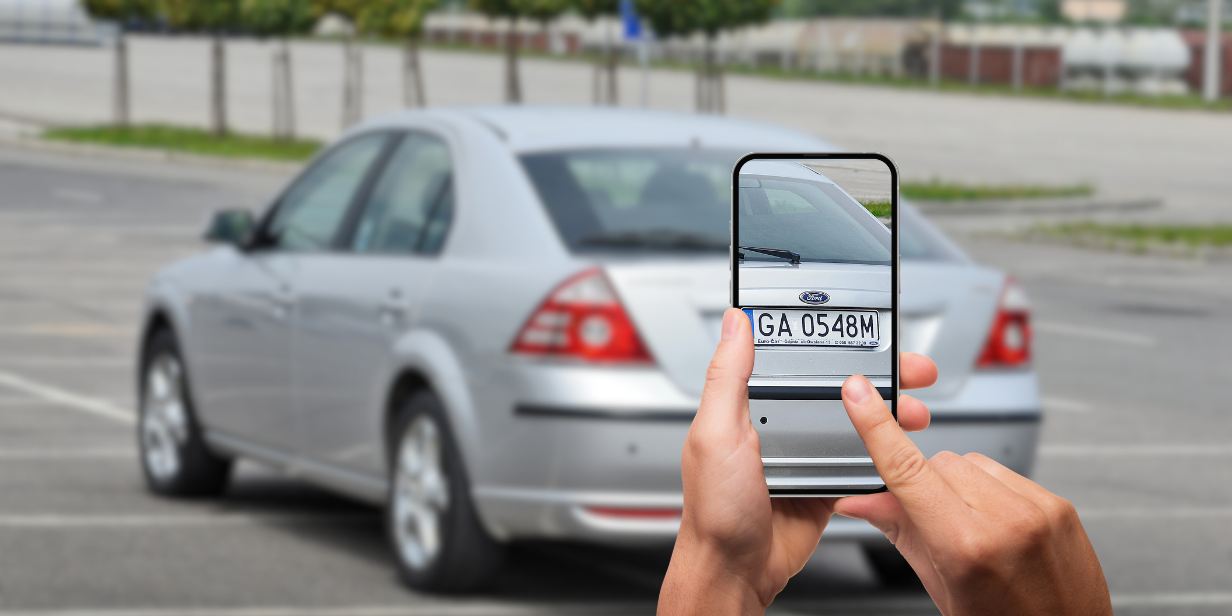
ANPR, short for Automatic Number Plate Recognition (or Automatic License Plate Recognition, ALPR, in certain regions), is cutting-edge software that has made license plate decoding easier. Traditionally, it is confined to stationary cameras like roadside units and closed-circuit television. But in recent years, this technology has now evolved and made its way to the mobile world.
In this article, we learn about the boundless possibilities of ANPR for mobile phones. Whether you’re in parking management , vehicle inspection, or fleet management , you’ll uncover the potential of integrating ANPR technology directly into smartphones.

Person taking a photo of a car’s license plate. Source: Canva
ANPR for mobile phones puts the technology directly in the hands of users and enables ANPR technology to be used in a variety of environments. The need for ANPR on mobile phones arises from its numerous advantages:
Portability and Convenience. ANPR technology integrated into mobile devices offers effortless and on-the-go license plate recognition, making it convenient for users.
Real-time Accessibility. Mobile phones’ internet connectivity enables real-time access to cloud-based ANPR services, ensuring quick data processing and accurate results.
Cost-Effectiveness. Deploying ANPR for mobile phones eliminates the need for expensive infrastructure setup, making it a cost-effective solution.
Enhanced User Engagement. Putting ANPR power in users’ hands improves productivity and empowers quick and informed actions based on real-time data.
Seamless Integration. ANPR solutions for mobile phones come with user-friendly SDKs and APIs, making integration into existing mobile applications straightforward for developers and users.
ANPR for mobile phones fulfills the need for a flexible, efficient, and accessible license plate recognition solution that can revolutionize various industries’ operations.

Person taking a photo of a car’s license plate. Source: Canva
When it comes to ANPR solutions, traditional stationary systems have long been the go-to choice. However, the advent of ANPR for mobile phones brings a new dimension to the table. Let’s make a comparison of these two approaches and see why mobile ANPR might be a better fit for certain situations.
Traditional stationary ANPR systems require significant investment in infrastructure, including fixed cameras, mounting hardware, and power supply installations. On the other hand, mobile ANPR leverages the existing camera technology on smartphones, eliminating the need for costly setups. This makes ANPR for mobile phones a cost-effective option, particularly for businesses or organizations with budget constraints.
Setting up traditional ANPR systems can be time-consuming, involving complex installation and calibration processes. On the other hand, ANPR for mobile phones can be quickly deployed by integrating a software module into existing mobile applications. This quickness in deployment ensures fast implementation and allows for immediate utilization of the technology.
Mobile ANPR offers ease of use for users on the ground. With just a few taps on their smartphones, they can capture license plate data and obtain instant results. On the contrary, traditional ANPR systems may require specialized training for operators to handle equipment and interpret data effectively.
As businesses grow or requirements change, scalability becomes a critical consideration. Traditional ANPR systems may face limitations in scaling up, as expanding infrastructure can be complex and costly. Mobile ANPR, on the other hand, effortlessly accommodates scalability, as it relies on the ubiquitous presence of mobile phones.
Mobile ANPR presents a level of flexibility that traditional systems struggle to match. Its mobility allows it to be used in various environments and applications, from law enforcement on the move to parking management in crowded areas. This adaptability makes mobile ANPR a versatile tool for a wide range of scenarios.
Traditional ANPR systems may require additional infrastructure for real-time data access and processing. Mobile ANPR, with its internet connectivity, seamlessly connects to cloud-based services, enabling real-time access and swift analysis of license plate data.
While traditional stationary ANPR systems have their place, mobile ANPR emerges as a compelling alternative. Its cost-effectiveness, deployment speed, ease of use, scalability, flexibility, and real-time connectivity make it an excellent choice for situations where agility, accessibility, and cost-efficiency are crucial. As technology continues to evolve, mobile ANPR is poised to become an indispensable tool in modern license plate recognition applications.